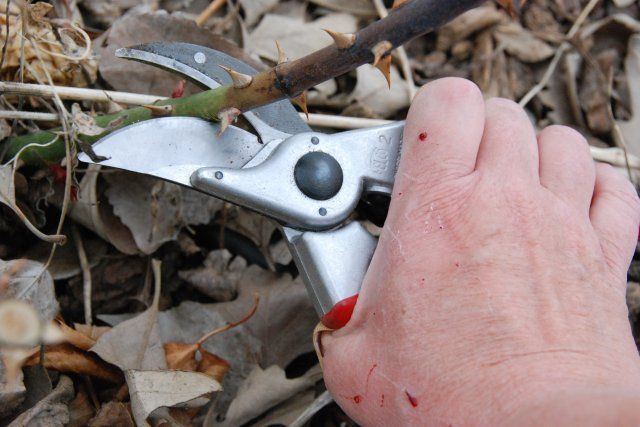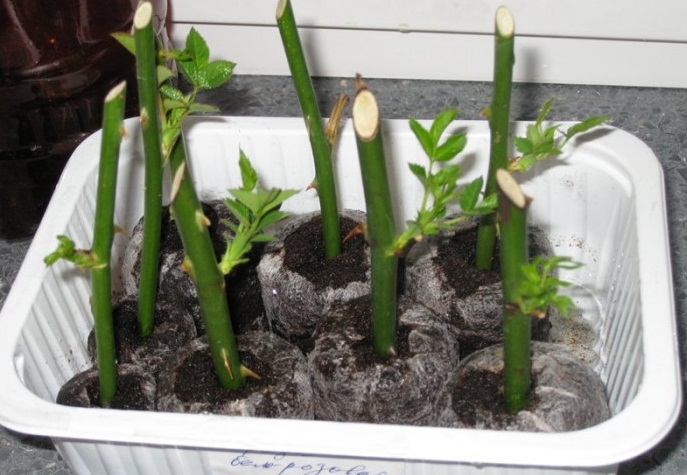Rose Frederic Mistral - characteristics of the flower
Content:
The Frederic Mistral variety was bred in the 90s. last century in England. Breeders sought to combine the beauty of the bud with delicate color and disease resistance, which they managed to accomplish.
Main characteristics
The plant of this variety is vigorous, the average height is from 90 to 150 cm. The upright thick branches disintegrate as they mature, creating a voluminous shrub. The size of one flower when closed is 10-12 cm, and when opened, the diameter increases to 20-27 cm.
No more than five flowers can bloom on one bush, but more often it is one. Gradually opening up, it becomes terry. The styling of the petals is classic, which gives volume. The color varies slightly within a pale pink hue. The inner side is darker. With fading, a slightly noticeable dusting of white appears, which even more smoothes the color.
The stem and elongated leaves have a bright dark green hue. They are less susceptible to disease. If it rains early in September, brown spots may appear.
In addition to resistance to microbes and fungi, the variety has an excellent flowering duration - from one and a half to two months, subject to warm weather with minimal rainfall. With careful care, the cut flower can be stored for a long time.
Disadvantages of the Frederic Mistral variety:
- inability to frost, temperature changes, the need to cover with sacking for the winter;
- unsuitable for high humidity.
When planting, the position of the shrub is taken into account, since it is necessary to prepare a place for active growth.
Preparation and disembarkation
To prepare for planting, you need to choose a location for the bush. The soil should be neutral or slightly acidic. It is worth refraining from planting in clay soil, otherwise the rose will die from a lack of substances and the hardness of the soil. Wet or even marshy areas are also unsuitable for the cultivar.
Frederic Mistral is a rose that loves the sun and does not tolerate shade, so she will like open, well-ventilated spaces more. At the same time, the flowers do not lose their color. However, high heat above 30 ° C spoils the appearance of the buds, deforming the petals. To preserve the species, you will have to cover the plant with a light cloth and water more often.
Landing time and order
In order for the flower to take root, preparations begin in mid-March. The root is moved to a cool place, adding mineral fertilizers if necessary. By the end of May, subject to stable warm weather, they organize a landing:
- Prepare the pit. Its parameters depend on the size of the seedling. The main rule is the absence of trauma or bending of the root. Usually 50 cm deep and 35 cm in diameter is sufficient.
- The fertilizer mixture is poured into the bottom. Rose Mistral is not whimsical, but in the early days the plant will need strength to adapt.
- The roots of the bush are carefully cut 1-2 cm.
- Place a bush and carefully cover it with earth.
- After completion, be sure to water the rose Frederic Mistral.
Care
The rose will not take root in soil poor in minerals, as well as in too dry or too wet soil. Water the plant:
- after disembarkation, and until it takes root twice a week;
- during active growth, you can reduce the procedure to a single watering for seven days;
- with the formation of kidneys, the process must be increased again;
- cut again during flowering.
Top dressing and loosening
Loosening of the earth around the bush is carried out monthly, as well as after irrigation and after fertilization with special compounds. Top dressing needs to be done:
- industrial complex fertilizers after pruning branches in the spring;
- potassium sulfate in late spring or early summer;
- during the flowering period, you need to refrain from feeding;
- potassium sulfate in the autumn after flowering and before the first frost.
Pruning and replanting
Pruning should be done with a disinfected and sharp instrument. Preventive maintenance is carried out monthly: dried buds and leaves are removed. Before leaving for the winter, the plant is also prepared by removing the upper 8-12 cm from the stem, and the cut is treated with activated carbon, which is finely pounded for this.
The transplant must be organized during the early spring, as well as the planting. Water the plant abundantly the day before the date. At the newly selected location, they dig a deep hole at least 60 cm deep and 45 cm in diameter. Half of it is filled with a mixture of sand and humus, and then rammed with watering. The root is carefully placed without creases, the voids are filled with mineral fertilizer. Cover with earth and watered again.
Wintering
Since the rose does not tolerate frost, it is covered with burlap or spunbond. How to do it right:
- Tuck the ground around the plant and cut off all the leaves.
- Lay dry leaves and branches at the base. Some gardeners use spruce branches.
- Carefully bend the stem, lay it on a layer of dry plants, secure it with an iron bracket.
- An iron frame is installed on top, which is covered with a prepared cloth. Secure the ends by digging them into the ground. But you need to leave a small opening of 15-20 cm so that excess moisture comes out through the hole.
Blooming rose
No written description compares to the actual species of the genus Frederic Mistral. The pale pink flowers bloom at the end of July, but the buds are tied at the beginning of the month. Slow opening is accompanied by a gradual build-up of sweet aroma.
Reasons for the lack of flowers
A rose does not bloom if:
- the technology of transfer or disembarkation is violated;
- the roots froze over during wintering;
- the place of growth is windy;
- the soil or climate is not suitable for the plant.
Reproduction
Frederic Mistral roses are propagated by cuttings. To do this, in the fall, cut off a shoot with a length of 20 to 40 cm, place it in the ground and leave it in a cool, dark place. In early March, before planting, a cutting is dug up and placed in water for an hour and a half. When it grows roots, you can transplant it into open ground.
Diseases
Frederic Mistral is a variety that is resistant to many pests and diseases. But sometimes this plant also has ailments. Frequent diseases:
- powdery mildew. It looks like a dense white bloom, it is treated with a solution of soda and warm water. For 1 liter before processing, 30-35 g of baking soda is dissolved, the bushes are sprayed completely;
- aphid is a green insect. To get rid of you need to prepare a decoction. A piece of laundry soap is rubbed onto a 10-liter bucket of water and a wormwood bush is added. The mixture is brewed for 20 minutes, after which the bush is sprayed.
Rose Frederic Mistral is hardy and unpretentious.The beautiful appearance and long-lasting aroma, combined with a long flowering period, will surely make the bush a decoration of any garden.



















